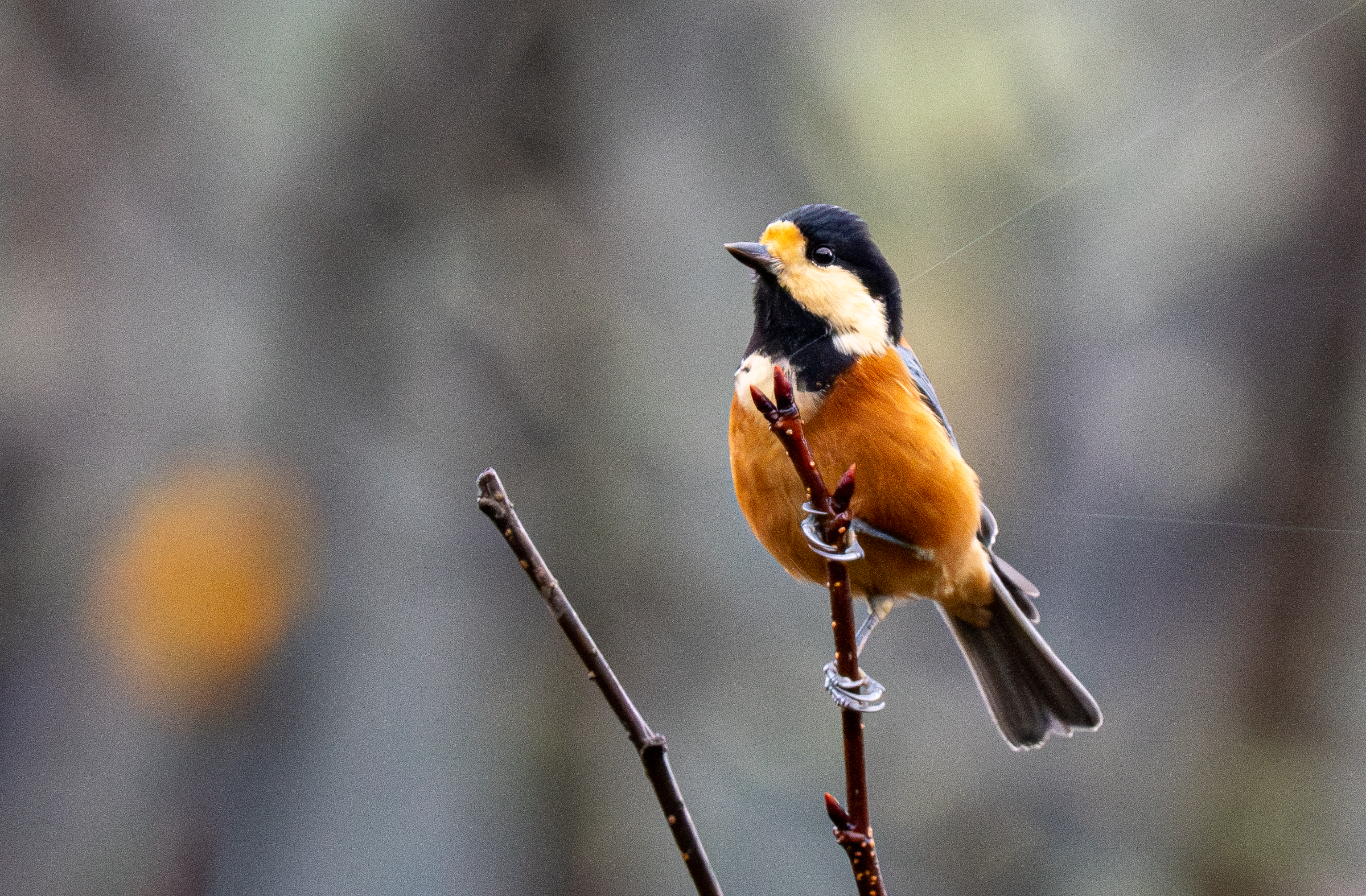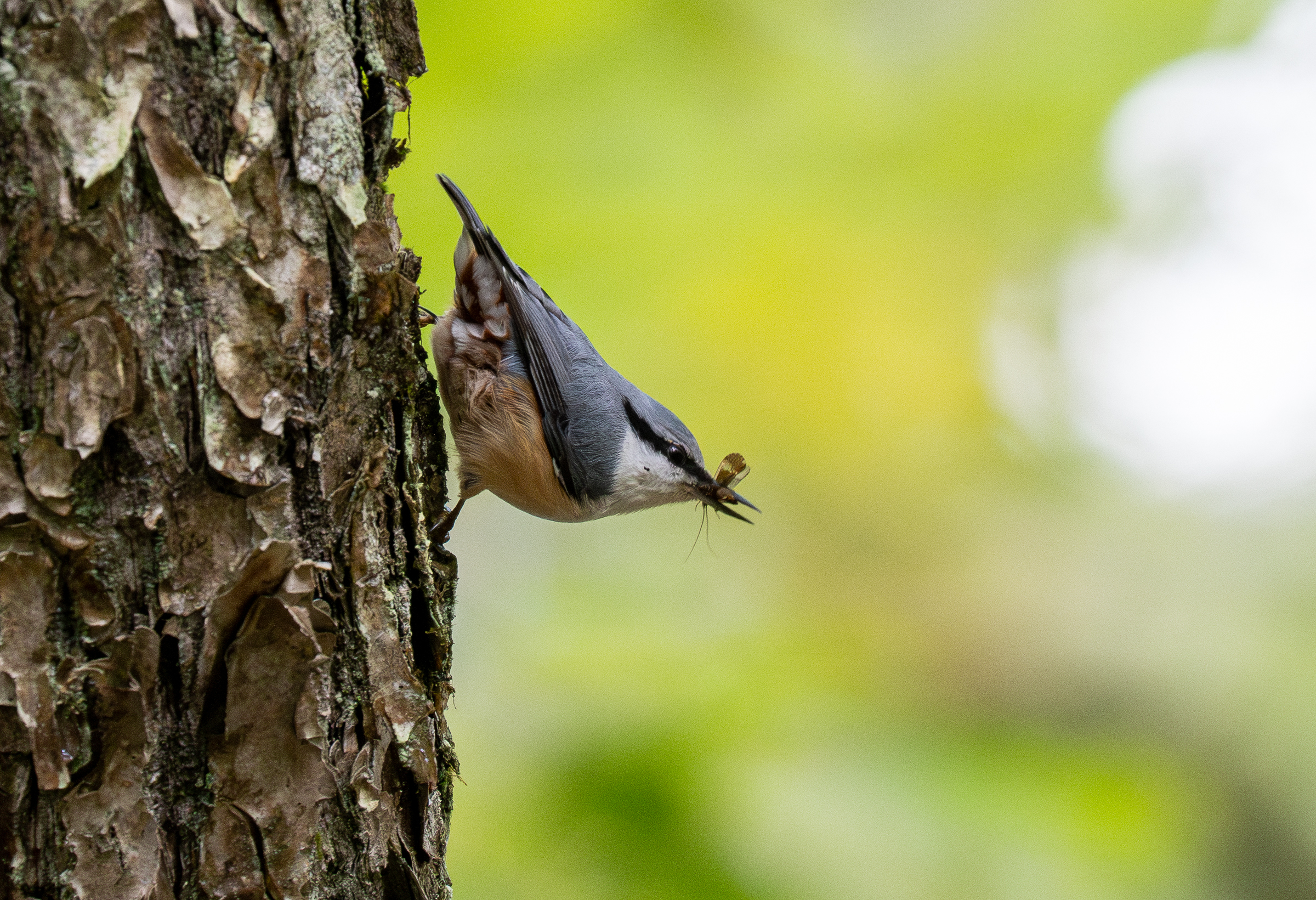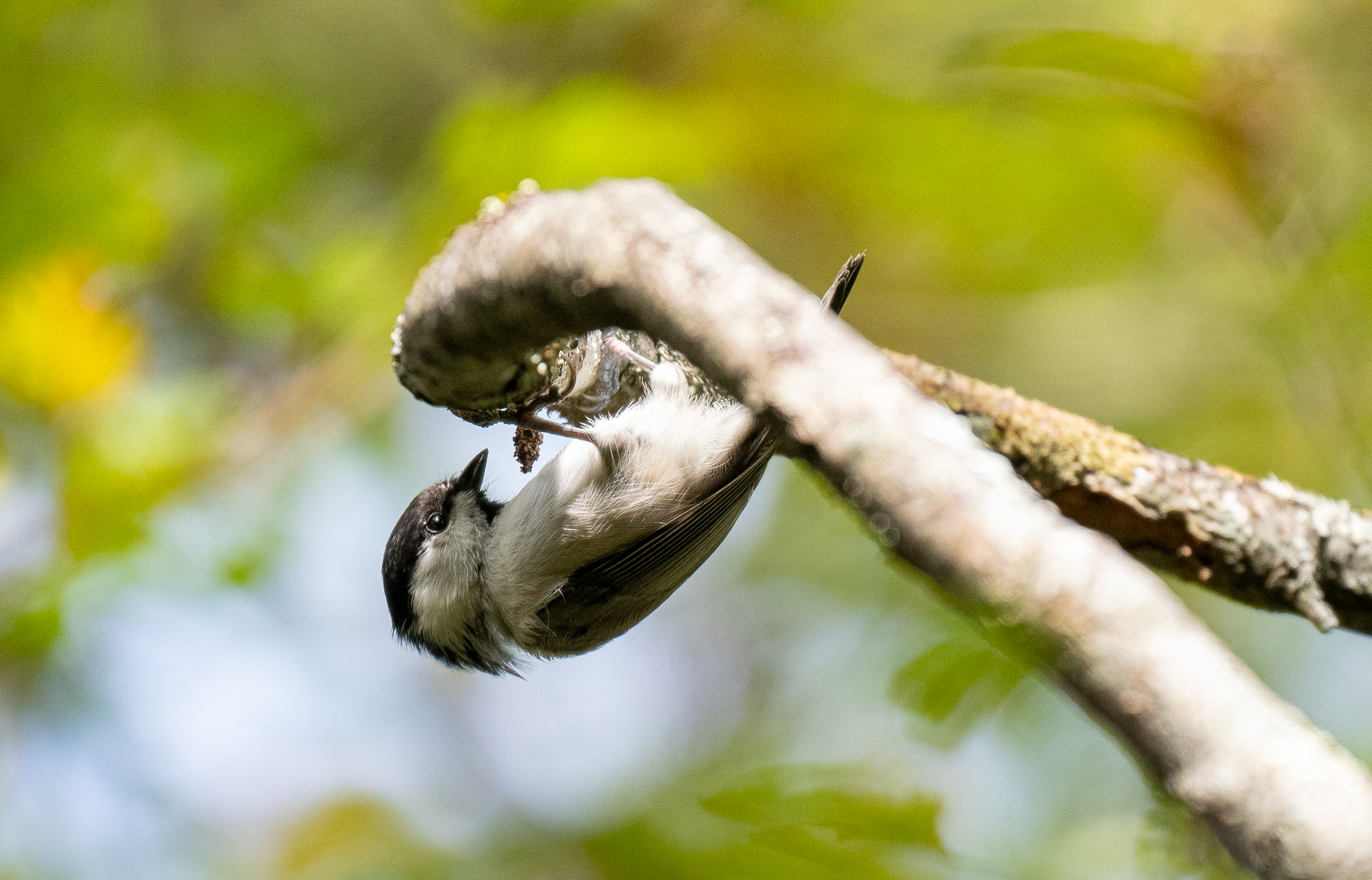Most of our trip to Japan was spent in Tokyo, and most of that wasn't spent birding but rather checking out museums, temples, and food places. Thankfully Nikki had built in two days outside Tokyo into our itinerary, which was set aside for a visit to Nikkō National Park, a park in a mountain area of Tochigi Prefecture a couple hours north of Tokyo. Nikkō is famous for its spectacular scenery, including many lakes, waterfalls, and mountains, as well as its many temples and shrines that have made it a UNESCO World Heritage Site. It was a great excuse for us to get out of the city, and I was greatly looking forward to some time outside of the concrete jungle.
We left Tokyo early on the morning of October 4, taking the high-speed train that went directly to Nikkō from Asakusa station near our hotel. It wasn't quite the shinkansen but it was still a wonderfully comfortable way to travel, with big seats, lots of legroom, and even meals offered on board. After all of my flying this year I increasingly appreciate good land transport options, especially when they're as fun and efficient as train travel. That's something both the US and the Philippines could stand to learn from Japan...
It was late morning by the time we arrived at the train station in Nikkō, and we noticed two things immediately. First, it was much chillier up here in the mountains than it was in Tokyo, forcing me to wear long sleeves for the first time in months. Second, it was pouring rain! We had scheduled our trip for the few days that week with the best weather forecast, but apparently the weather wasn't looking at the same forecast we were. It didn't seem like the best weather to start our nature trekking, so we braved the rain and dodged some mud puddles to get to a little cafe where we could wait for the rain to stop.
 |
| Mountain foothills from the train window |
 |
| The Nikkō town square |
Eventually the rain let up a little so we headed back to the station to take the bus to the national park. The actual park is an hour's drive uphill from Nikkō town proper, but thankfully there's a public bus running regularly all the way to the top of the valley, and Nikki secured an unlimited bus pass for us. I've never been in any other national park that was that easy to navigate without a car- just another thing Japan is way ahead of the rest of the world on.
The bus took us through the beautiful town of Nikkō, full of quaint little country homes, cool temples, and many onsen, then up a set of several dozen hairpin turns until we got to the lovely mountain lake of Chūzenji. The landscape was absolutely gorgeous, with precipitous mountain slopes and valleys filled with moss-covered maples and spindly oaks. It wasn't quite fall color season, but there were bits of orange and red starting to appear in the highest parts of the mountains near the tree line. Our destination was Yudaki Falls, the second-tallest of the three major waterfalls in Nikko. It was a 90-minute bus ride until we got to the spot, and of course it was still cold and rainy when we got off the bus and started walking down the access road to the falls. The waterfall itself was extremely impressive- a huge diagonal cascade falling down from the small Yunoko lake above it. We got our requisite pictures and then immediately rushed inside to the little rest house next to it, where we ordered smoked fish and drinks from an old man with some suspiciously missing fingertips.
 |
| Lake Chūzenji from the bus |
 |
| The forest near the falls |
 |
| Yudaki Falls |
 |
| The stream below the falls |
We had hoped to spend some time hiking around in that area, but it was cold and rainy and not really the sort of weather that lent itself to outdoor activities. Instead we headed back to the bus after warming up and eating our Yakuza fish and started heading back downhill. We stopped at the little town at the base of Chūzenji Lake, which was home to Kegon Falls, the main attraction of Nikkō. It took us a little while to find the right path to the falls, but once we were there the view was breathtaking: it's one of the tallest waterfalls in Japan, over 300 feet tall, cascading over the lava flow from nearby Mount Nantai that dammed the Yukawa River and formed the lake and the waterfalls. The weather was still abysmal, but at least the views were worth it.
 |
| Kegon Falls |
It was afternoon by then, so we set about looking for somewhere to eat lunch. There was barely anything open in the little town by the falls and most of the places that were open had terrible reviews, but finally we found a little traditional restaurant that served some decent fish and (more importantly) hot beverages. As we walked back to the bus, we surprised a Japanese Macaque that was walking along the sidewalk! It had apparently just been rummaging through dumpsters, as it was carrying a bag of take out food that it proceeded to eat while sitting on a porch looking at us. I was sort of hoping to see them chilling in a hot spring or something, but a lifer mammal is a lifer mammal.
 |
| Japanese Macaque |
Back down in Nikkō town, we gathered our bags where we had stored them in the train station and went to our hotel to check in. Nikki had booked us at a little bed and breakfast uphill from the train station, which proved to be nice and cozy with very friendly owners. Everyone was cold, wet, and tired and mostly we wanted to stay inside the hotel and warm up the rest of the day. I did do a little walking around just before sunset to see if I could find any birds, as this had been an almost entirely birdless day. I eventually found a bridge crossing the Daiya River and was able to enjoy the cloudy, misty sunset in the river valley. The birds were scarce, but I did see a few Brown-eared Bulbuls and a single Eurasian Jay which was a lifer for me. The river looked like perfect habitat for Brown Dipper, but I didn't see any before it got dark.
 |
| Sunset on the Daiya River |
That night the owner of the hotel took us back down into the main town to eat at a little izakaya (traditional bar) which was among the better meals we had in Japan. The plan was for us to return to Tokyo the following day at midday. However, I had also been hoping to get some proper birding in while I was in Nikkō, which had proved to be impossible on the first day thanks to terrible weather (in fact, I'd seen all of about 5 birds all day). The forecast for the next day was halfway decent, so I decided to extend my stay in Nikkō until the afternoon so that I could have a day to bird in the upper elevations. Nikki, her mom, and her sister returned to Tokyo a little bit earlier so they could escape the cold.
Birding in Tokyo had been rather underwhelming for me, without many migrants and not even all that many resident birds either. A glance at the eBird hotspots around Nikkō told me that it had much more of interest, mostly deep forest birds that didn't really get into Tokyo in the summer and fall months. Most of these were birds that have extremely wide ranges, from Japan all the way to western Europe, but since I've barely birded in the Old World outside of the tropics, even the rather common stuff would be a lifer. Despite being a country composed of very large islands, Japan has a surprisingly small number of endemics, and most of those are found on random small islands rather than the largest island of Honshū where I was. I suppose those will be my targets next time I'm in Japan, but for now I was happy to look for the Palearctic birds.
I got up at sunrise and headed back to the bridge I'd been at that night, hoping for more interesting stuff. That actually paid off quite well, as the first bird I saw was a Brown Dipper darting from rock to rock in the river! Dippers are some of my absolute favorite birds, so this was a much-wanted lifer for me. What they lack in colors they make up for in fascinating behavior, dipping in and out of the water like they're defying the laws of physics.
 |
| Brown Dipper! |
I watched the dipper for a while then crossed to the other side of the river, where the bridge ended in a little path through a garden and a wooded area. There was some bird activity this time, most especially a flock of tits that included the usual Japanese Tits and Varied Tits, but also a few Coal Tits, another lifer for me. The Coal Tits remained mostly far away but the Varied Tits put on an absurd show- surely some of the best-looking birds in Japan. I had a quick flyby from a Great Spotted Woodpecker and there were a few Eurasian Jays around, but they remained frustratingly difficult to get a good look at, allowing only distant flight pictures.
 |
| Coal Tit |
 |
| Varied Tit |
 |
| Eurasian Jay |
I went back to our hotel to have breakfast with Nikki and her family, then departed once again to take the bus uphill to the park while they stayed below to visit some temples and hot springs. My destination for the rest of the morning was the Senjogahara Moor, a wide, flat expanse of marshy forest above Chūzenji Lake. eBird told me that that was where most people go birding around Nikkō, and there was a chance at at least a few lifers, though it was unclear how easy that would be.
 |
| The road at the start of the trail |
Things started off pretty slowly, without too many birds singing near the trailhead. I did see a few Amur Stonechats hanging out in the moorland near the road, along with a spectacular view of the moor and the mountains behind. As I started walking down the trail I noticed a little bird foraging very unobtrusively in the undergrowth, which proved to be a Masked Bunting, a lifer for me. There were a few other bird calls, including a distant flock of Long-tailed Tits and some heard-only Eurasian Jays, but so far the birding was underwhelming.
 |
| Eurasian Nuthatch |
The nuthatches proved to be the vanguard of perhaps the largest mixed feeding flock I have ever seen. In fact, for the next 45 minutes or so I was immersed in a vast cloud of hundreds of birds as they moved through the forest, including most of the lifers I'd hoped to see up in Nikkō. It started with a couple of adorable Eurasian Treecreepers, but those were quickly followed by Varied Tits, Japanese Tits, Coal Tits and my lifer Willow Tits, the latter pretty much an exact copy of North American chickadees. A tiny fast-moving bird in the canopy proved to be a Goldcrest, and it was joined by a silent Phylloscopus warbler that I eventually IDed (with the help of iNaturalist) as an Eastern Crowned Warbler, another lifer. There were woodpeckers too: a gorgeous Great Spotted Woodpecker, a couple of tiny Japanese Pygmy Woodpeckers, and finally a Japanese Green Woodpecker, actually the only true Japanese endemic bird I saw the whole trip. An early Brambling and a single Olive-backed Pipit were more additions to my Japan list. It was one of my favorite birding experiences of the year, and I managed to almost completely fill my memory card as I tried to photograph as many species as I could.






 |
| Eurasian Treecreeper |
 |
| Some people say this is a Willow Tit, but I'd call it a dead ringer for a Black-capped Chickadee |
 |
| Goldcrest looks like a weird hybrid between Ruby-crowned Kinglet and Golden-crowned Kinglet |
 |
| Eastern Crowned Warblers are supposedly more boldly-patterned than other Phylloscopus warblers but I have to say I'm not impressed |
 |
| Brambling |
 |
| Japanese Pygmy Woodpecker is not actually endemic to Japan, despite the name. In fact, of the 17 species of bird with "Japanese" in the name, only 2 of them are endemic to Japan. I find this deeply annoying. |
 |
| Japanese Green Woodpecker is, thankfully, an actual Japan endemic. |
 |
| Great Spotted Woodpecker |
 |
| Olive-backed Pipit |
 |
| Scenes from the trail |
Eventually the birds moved on, and I continued down the trail. It was a three and a half kilometer walk to the other end of the trail, but in the remaining three kilometers or so I saw only a fraction of the birds that I'd had within the single megaflock. In fact, for most of the hike I didn't see or hear any birds at all. Forest birding can be weird like that sometimes. At one point I came across a mass of bird photographers all looking at something in a field, but in typical Japan fashion they didn't bother to point whatever it was out to anyone. I eventually realized that it was just a pair of distant Amur Stonechats, with the male doing occasional displays. Lack of birds aside, the scenery was breathtakingly gorgeous, with the yellows, greens, and grays of late summer foliage blanketing the moor and forest-covered volcanos looming in the distance. I was glad I had managed to make it up there again, as none of this had been visible in the rain and fog the previous day; I only wished the others could have seen it too.







 |
| Displaying Amur Stonechat |
 |
| Autumn Darter |
 |
| Marmalade Hoverfly on a Korean Gentian |
Just as I was thinking to myself how nice it was to be up there without rain, I noticed an ominous silver-grey mist advancing ominously towards me from the mountains ahead. There was no shelter anywhere, so I couldn't do much except keep onward and watch the raincloud get closer. Thankfully it was mostly just a light drizzle and I had my raincoat to protect my camera gear, so it was only a mild inconvenience. I arrived at a small pool in the river labeled Izuminoyado pond, which had a number of Mallards and Eurasian Teals, but much more interestingly a Brown Dipper! I spent quite a while watching it preen itself on a log and tried to get some better photos, although they came out rather hazy because of the drizzle. It was still lots of fun with my favorite bird of the trip.
 |
| Eurasian Teal |
 |
| Brown Dipper |
 |
| Japanese Stink Bug (Pentatoma japonica) |
 |
| Thysanoplusia intermixta |
After a few hours of hiking I reached the end of the path, passing about 400 Japanese middle schoolers on a school trip along the way. I decided to take the Nikkō bus up to the very end of its route, in the tiny town of Yumoto. Yumoto is mainly known for its volcanic hot springs, and has a few traditional
onsen (bath houses). I can only hope the
onsen are good, because the main things I noticed about it were that it was bloody cold and that the whole town smelled of sulphur. October is still late summer in most of Japan, but at this elevation it felt more like proper autumn weather. I spent a bit walking around town and checking out the hot springs, but was more than happy to get on the next bus going downhill.
 |
| The yumoto hot springs- just looking at this picture brings back fond memories of walking around in freezing drizzle in a town that smelled like rotten eggs |
I took the bus all the way back down into Nikkō town, picked up my luggage, and boarded the train back to Tokyo to rejoin with Nikki. As I neared the city I caught a glimpse of Mount Fuji just before sunset- the only time I actually saw it during my whole stay there. It was a nice end to an excellent 2-day trip out of Tokyo, and definitely my favorite outing of our time in Japan. It was a good reminder that Japan actually does have good birding in some spots- something I hope to do quite a bit more of next time I visit.
 |
| Mount Fuji from the train |



























































































Comments
Post a Comment